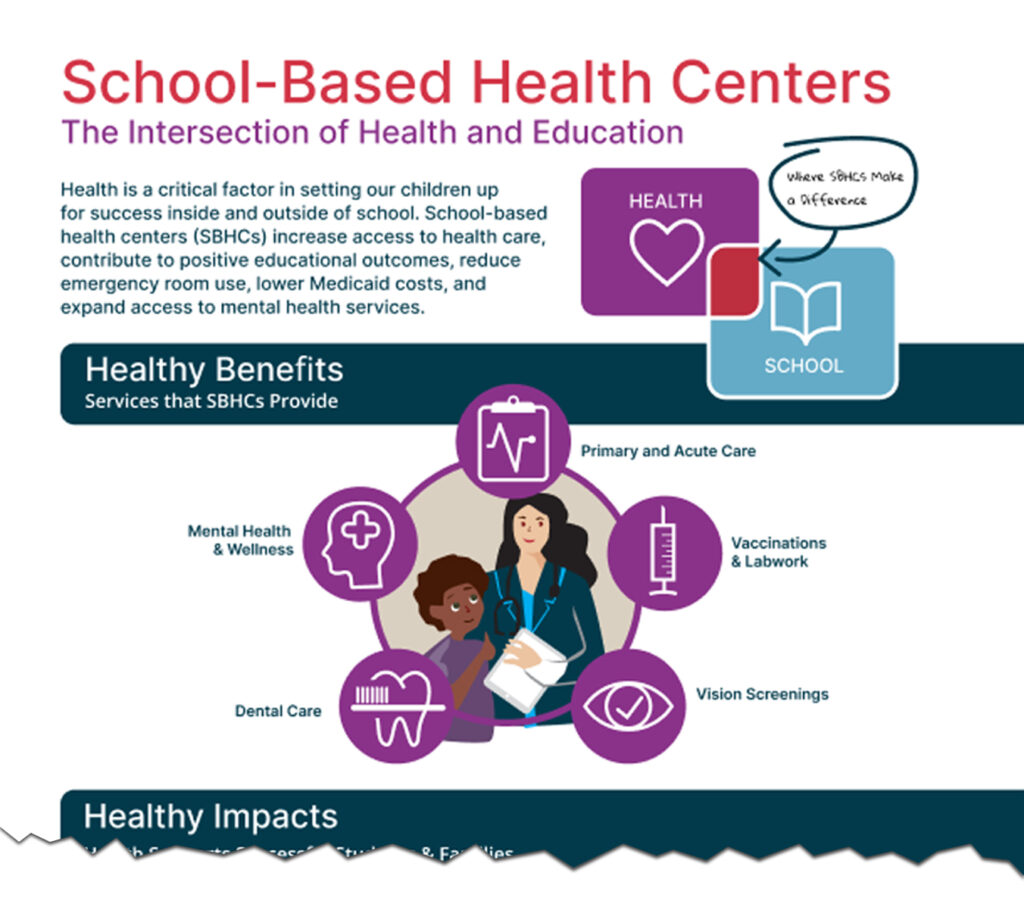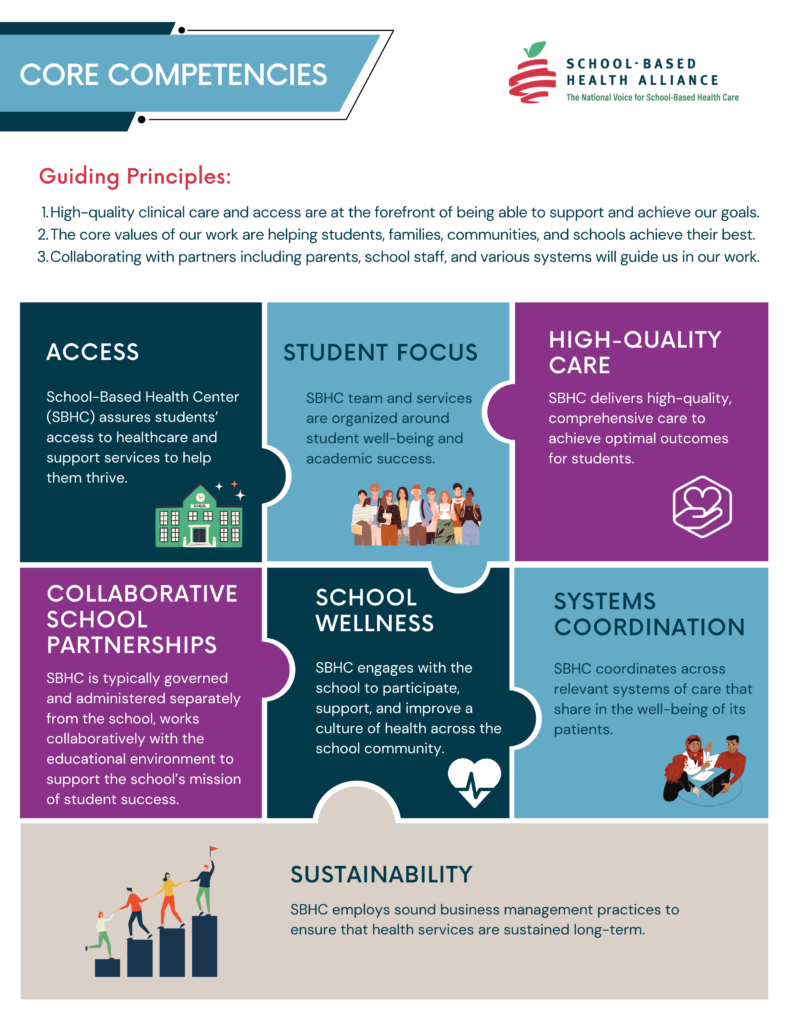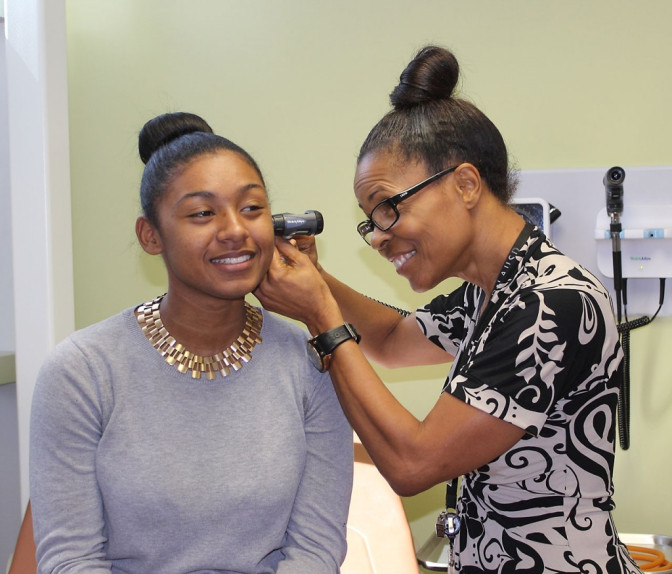About School-Based Health Alliance
Learn about our vision and values, our goals and our approach, and the core competencies for school-based health centers.
Who We Are
School-based health care is a powerful tool for achieving health equity among children and adolescents who unjustly experience disparities in outcomes simply because of their race, ethnicity, family income, or where they live. It’s an idea that has gained currency across the country: place critically needed services like medical, behavioral, dental, and vision care directly in schools so that all young people, no matter their ZIP code, have an equal opportunity to learn and grow.
At the School-Based Health Alliance, we’ve worked for over 25 years to:
- Advance national policy and legislative priorities for the field
- Advocate for greater support and funding
- Promote high-quality clinical practices and standards
- Support data collection and reporting, evaluation, and research
- Provide training, technical assistance, and consultation
Strategic Focus
01
OUR VISION
We strive to create communities where all children and youth are healthy and successfully learning to thrive in life.
Where children:
- Are accessing everything they need to reach their highest potential.
- Live in safe, thriving homes and neighborhoods.
- Live among adults who value, care for, and protect them.
- Have a sense of self-worth, value, and agency about their own wellness (health/well-being).

02
OUR BELIEFS
We believe:
- School-based health care creates health equity for students from low-income communities;
- Cross-sector collaboration, systems of care, and supports to create equitable opportunity for learning and health to all children—no matter their race, ethnicity, socioeconomic class, gender, sexual orientation, ability, or ZIP code—are critical to achieving health care equity;
- By working together, our schools, public health authorities, healthcare systems and providers, youth and family services, law enforcement and juvenile courts, community development institutions, interfaith and civil rights groups have the collective power to remediate the effects of detrimental social, environmental, and economic factors (also called root causes) on children’s health and academic success;
- When communities engage students and their families as active stakeholders, leaders, and change-makers in comprehensive, school-centered strategies, they can make every school a place of safety, belonging, connectedness, and limitless opportunity.
03
CORE VALUES
- We invest in people as critical resources for advancing our mission.
- We encourage continuous learning and challenging dialogue.
- We value hard work and balance in all lives to assure well-being.
- We value innovation, creativity, and the application of new ideas to solve complex problems.
- We hold ourselves accountable for results that are meaningful to our field.
- We strive for openness, inclusivity, collaboration, and diversity in our staff, members, and partners.
- We value inclusiveness, diversity, and equitable access to health care for all students from households that have low incomes.
- We budget conservatively and do not waste precious resources.
04
WHO WE AIM TO REACH
- School-based health care clinicians, practitioners, and administrators.
- Community health organizations delivering medical, behavioral, oral, and vision care.
- Federal, state, and local public health authorities.
- Federal, state, and local education agencies.
- State school-based health care affiliates.
- Foundations and philanthropies.
- Public and private health care payers.
- Elected leaders and policymakers.
- Traditional and social media.
- Students and families in K-12 public schools that serve communities of people who have low incomes.
05
OUR GOALS
- Maintain and grow the reputation of SBHA staff members as the subject matter experts on school-based health care.
- Secure federal budget line items for SBHCs both within the 330 program and for health care organizations that are not federally qualified health centers (FQHCs).
- Complete all projects and grants on time and on budget.
- Operate a national conference either virtually, in-person, or as a hybrid.
- Continue to grow our national partnerships and media relationships.
- Aggressively seek new funding (philanthropic and government) for workforce development and electronic data collection.
- Seek new funding for youth initiatives, including internships.
- Maintain staffing levels, increasing only where grants or projects require.
- Maintain a healthy work environment for staff.
- Seek funding for general operating expenses.

06
OUR APPROACH
Advocate to grow the number and expand the services of SBHCs nationally.
Through education and advocacy for federal and state policies supporting the growth, expansion, and funding of SBHCs, we will expand the number of SBHCs nationally. We will also pursue relationships with national partners and positive media opportunities that further the goal of having a fully staffed SBHC in every school that receives funds from the federal Title I program, which supports students whose families have low incomes throughout the nation.
Grow and diversify the school-based health workforce.
We will develop and implement plans and strategies to grow and diversify the school-based health workforce by working with national partners, federal agencies, and philanthropies. We will expand our youth outreach and activities to help us meet this challenge.
Disseminate best practices.
Our team, working with our national partners where possible, will share best practices and current information through learning collaboratives, consulting contracts, and training opportunities. We will provide tailored, in-depth technical assistance and consulting services on a fee-for-service basis to help communities design, plan, operate, and evaluate school-based health care programs. We will offer virtual and in-person events and activities.
Develop electronic data collection and analysis capabilities.
Working with our national partners, we will pursue government and philanthropic support for modernizing our data collection/analysis for all school-based health services. We will work with education partners to create better collaboration between sectors and address HIPAA and FERPA issues.
Expand the use of telehealth in schools.
Telehealth is a great tool for clinicians, but it does not replace in-person clinical professionals.

Infographic explainer
The full version of our infographic explains our work in an easy-to-understand visual format.
Core Competencies
A school-based health center (SBHC) represents a shared commitment between a community’s schools and healthcare organizations to support the health, well-being, and academic success of its students. For the schools’ parts, facilities, and utilities are donated and school and district policies facilitate students’ enrollment and usage of the center.
Local health organizations apply school expertise and linkages to an array of services—medical, behavioral health services, oral health care, nutrition services, vision services, and health promotion—that enable children and adolescents to thrive in the classroom and beyond. The ultimate goal of the partnership is to create a culture of health within the school community.
The School-Based Health Alliance, in partnership with our State Affiliates and experts from the school-based health care field, developed a set of seven core competencies that represent the knowledge, expertise, policies, practices, and attributes that we hope every SBHC can achieve in pursuing student wellness. SBHC staff and administrators can use these as a framework to achieve excellence in delivering care in a school setting. We recognize that each school and SBHC may be at different stages of implementation and hope that the guiding principles and core competencies help to encourage high-quality and optimal healthcare in schools.
Continue reading about the Core Competencies below, or download the following resources.

- High-quality clinical care and access are at the forefront of being able to support and achieve our goals.
- The core values of our work are helping students, families, communities, and schools achieve their best.
- Collaborating with partners including parents, school staff, and various systems will guide us in our work.
Access
- Location: SBHC is located in a facility—fixed within the school or in portable space—within the school building or campus.
- Modality: SBHC may have a more traditional brick-and-mortar model, or use mobile health and telehealth services to expand services and increase student access.
- Operations: SBHC makes on-site services available whenever the school is open or as needed to serve the student population’s needs. Student access increases when SBHC policies accept walk- ins, serve all students regardless of insurance status, and offer same-day appointments when possible. The school and SBHC have a clear protocol for referrals from faculty and staff.
- Facility: SBHC operates within an appropriate physical space that complies with laws and regulations governing health facilities, is conducive to efficient healthcare practice, welcomes students, and safeguards their privacy.
- Consent: SBHC uses a HIPAA-compliant consent form to obtain consent from parents/guardians of students. If the student is 18 or older, an emancipated minor, or able to consent under state minor consent laws, SBHC uses a HIPAA-compliant consent form to obtain consent from the student. SBHC seeks consent for bidirectional information sharing with school staff to share students’ health information as appropriate and necessary.
- After-hours care: SBHC puts in place a system for patients to access care when the center is not open (e.g., primary care physician on-call, nurse hotline, emergency room, urgent care center, or behavioral health crisis line).
- Access for all: SBHC serves all students regardless of race, color, sexual orientation, gender identity, religion, national origin, age, disability, gender, or sex. The SBHC serves every student regardless of their health insurance status or ability to pay. SBHC aims to address issues related to health equity by conveniently offering comprehensive services in schools to limit disruption of students’ education and reduce barriers to receiving care.
- Other populations: SBHC prioritizes the care of the student body and ensures their safety and privacy, even if they serve other populations (e.g., faculty and school personnel, family of student users, community members). This may be accomplished by offering student-only hours or organizing a separate entrance and/or waiting room area for non-students.
Student Focus
- Comprehensive service scope: SBHC delivers a wide range of primary care and behavioral health services, including vision and oral health, designed to promote the optimal physical, social, and emotional health of students based on student needs, as well as to minimize the effects of poverty, chronic disease, social influencers of health, and other adverse childhood experiences on their school success. Behavioral health needs must be identified and addressed in school-based health centers, ideally through on-site services.
- Evidence-based standards: Evidence-based standards of care guide how SBHCs address well-care exams, immunizations, healthy weight, school failure, asthma, ADHD, exposure to violence and trauma, sexual and reproductive health, depression, substance use, and oral and vision health. Evidence-based programming requires staff training and appropriate intervention protocols.
- Strengths-based, healing-centered and trauma-responsive care: SBHCs seek to identify protective and resiliency factors through utilizing asset-based screening tools to highlight and focus on individual strengths. SBHCs are guided by trauma-informed practices, meeting students where they are and understanding the whole child and possible traumatic experiences they may carry with them. Providers recognize these traumas and understand the implications of trauma and how that impacts individuals differently.
- Competence: SBHC services and materials are developmentally appropriate and respectful of cultural, linguistic, and other social and environmental needs of students.
- Confidentiality: SBHC protects the confidentiality of patient information as required by state and federal law when transmitted through conversation, billing activity, telehealth or the release of medical records.
- Patient engagement: SBHC encourages students (as age-appropriate) to be effective advocates and consumers of their healthcare by encouraging them to schedule their appointments, manage medications, ask questions about their care, and improve their health literacy.
- SBHC advocates for and seeks feedback from patients of various backgrounds: The health center initiates conversations to ensure diverse perspectives and equitable access are at the forefront of critical decisions.
- Youth advisors: SBHCs meaningfully engage students in various functions, including community asset mapping and needs assessment, evaluation of services, youth-led outreach and promotion, peer-to-peer health education, and advocacy mobilization for their health needs.


High-Quality Care
- Quality care: SBHC strives to provide high-quality care, following nationally established pediatric and adolescent guidelines and recommendations, including implementing evidence-based practices.
- Quality improvement: SBHC implements a continuous quality improvement process that monitors and evaluates the appropriateness, effectiveness, and accessibility of its services.
- Satisfaction: SBHC routinely assesses student and community satisfaction with services and assesses unmet needs.
- Performance and accountability: SBHC collects clinical, business, and academic data (when available) and reports on key performance measures, including individual and population-level outcomes, to ensure accountability to partners, payers, funders, and other stakeholders.
- Meeting diverse student needs: SBHC analyzes trends, reviews satisfaction surveys, and ensures that every student receives the care and services that they need and that SBHCs are equipped to meet the varying needs among different student populations. Health centers are intentional in professional development training, including topics on cultural humility, implicit bias, cultural considerations, etc.
Collaborative School Partnerships
- Shared vision for student success: SBHC has a formalized understanding of how its staff collaborates with school administration, teachers, and support staff, including school nurses, psychologists, counselors, and social workers, to ensure the partnership meets student needs efficiently, effectively, and seamlessly.
- Intentional systems planning: When possible, SBHC staff and school personnel jointly develop policies and procedures and structures supporting student health and academic achievement.
- Shared outcomes: SBHC partners with the school to achieve improved outcomes for students struggling with attendance, behavior, or academic performance issues.
- Collaborative practices: SBHC and school personnel work together collaboratively to address issues through ongoing training and professional development. Continuing support and collaboration strengthen the work and outcomes.
- Crisis response and support: SBHC partners in supporting the school’s crisis prevention, intervention, and postvention plans with clear roles and expectations. Crisis prevention includes activities that reduce risk and promote healing. Intervention includes identifying students who may be at-risk for suicide. Postvention includes supporting schools after the loss of a student.
School Wellness
- School climate: SBHC actively participates in and supports building-level policies and practices that assure a safe and healthy school environment for all students and staff. SBHC staff engages with the school to assist in making a positive difference in the school climate.
- Student body wellness: SBHC advances population health and preventive services through group, classroom-based, and schoolwide inclusive modalities to screen for and minimize risk factors, promote community assets, and address social influencers of health. Focus should be to highlight and promote the mental well-being of children and adolescents through screening and prevention programs.
- Family wellness: SBHC engages families in health education and promotion events to promote wellness.
- Staff wellness: SBHC assesses the health and wellness needs of school staff and offers services, such as support groups, stress management activities, health literacy, and health education.
- Health expertise and consultation: SBHC contributes subject matter expertise on health education curriculum, school wellness policies, and health-related programs and services that support student well-being. SBHC staff members also provide consultation and expertise in school policies and procedures and address any health or mental health-related issue within the school community.
- SBHC works to advance equity for all students: SBHCs provide programs, publications, and presentations that reflect diverse groups and populations.
Systems Coordination
- Care coordination: SBHC coordinates and integrates efforts (including the exchange of health information as allowable by current HIPAA/FERPA laws) with existing systems— school health staff, primary care, behavioral health, oral health, vision providers, and health plans—to improve continuity of care, reduce fragmentation, and prevent duplication of services.
- Family engagement: SBHC informs and educates families about a child’s health issues and involves them as supportive participants in the student’s healthcare whenever appropriate and possible.
- Community health partnerships: SBHC has formal partnership referral and follow-up linkage agreements and protocols with the broader healthcare community to ensure access to after-hours care (e.g., primary care physician, nurse hotline, emergency room, urgent care center, or behavioral health crisis line) and coverage beyond clinical capacity—including oral, reproductive, behavioral, and specialty healthcare. SBHC also works with school and community partners to ensure access to nutritious foods, reliable transportation, suitable housing, and other social influencers of health.
- Inclusive partnerships for student care: SBHC works to establish relationships with agencies and referral sources that embrace principles and make services available to all students regardless of their ability to pay. SBHC also works to develop relationships with care partners with similar racial/ethnic backgrounds to the student population when available.

Sustainability
- Administrative systems: A fiduciary (or sponsor) agency provides administrative and clinical procedures, including medical supervision, liability coverage, human resources, procurement of medical equipment and supplies, quality improvement, training and leadership development, health information technology, marketing, and practice/fiscal management.
- Billing infrastructure: SBHC can collect patient revenue efficiently through health information management systems, dedicated administrative personnel, and policies and procedures.
- Analysis of financial standing: SBHC creates a business plan with financial performance metrics that consider, among other things, the program’s cost, expected patient volume by the provider, and payer source. All direct and indirect program expenses, including staffing, facilities, pharmacy, administration, billing, care coordination, and health promotion, are considered in monetizing services.
- Sustainable resources: SBHC employs sound and innovative business models based on financial planning strategies that rely on a diversity of stable and predictable funding sources, maximize patient revenue, and minimize the role of grants to support operations for the long term.
- SBHC ensures that all initiatives are maintained and a regular part of discussions: SBHCs can do this through ensuring staff have access to resources and support to carry out these practices, including professional development.